Suchergebnisse
GREENsChOOLENERGY - Entwicklung und praktische Umsetzung von nachhaltigen Lösungen urbaner Hotspots in Kombination mit Begrünung/PV/Wasser
Nutzung der synergetischen Wirkung der Kombinationsbauweisen von innovativen Photovoltaik- Begrünungs- und Bewässerungssystemen am Standort der HTL1 Klagenfurt Lastenstraße zur Ertragsoptimierung der experimentellen PV-Elemente und gleichzeitigen Reduzierung urbaner Hitzeinseln.
Essbare Seestadt - Grüne Seestadt - Lernen für die essbare Stadt der Zukunft
Das Projekt "Essbare Seestadt" ermittelt, welchen Beitrag verdichtete urbane Nahrungsmittelproduktion zu einem klimaneutralen, resilienten Stadtteil leistet bzw. leisten kann und wie dieser Beitrag nachhaltig stabilisiert bzw. optimiert werden kann.
50 grüne Häuser - Entwicklung und Demonstration eines Low-Tech-Grünfassadensystems
Entwicklung einer kostengünstigen gewerke- und prozessübergreifenden All-In Gebäudebegrünung inkl. Wartungskonzept ("Greening-Toolkit") zur breiten (vor allem straßenseitigen) Implementierung auf Fassaden im städtischen Bestand, kombiniert mit einer Prozessinnovation zur Vereinfachung aller notwendigen Abstimmungsprozesse.
GREENsChOOLENERGY - Development and practical implementation of sustainable solutions for urban hotspots in combination with greening / PV / water
Use of the synergetic effects in the construction of photovoltaic, greening and irrigation systems at the location of HTL1 Klagenfurt Lastenstraße, to optimize the yield of experimental photovoltaic elements and at the same time reduce urban heat islands.
VERTICAL FARMING - Ermittlung der Anforderungsbedingungen zur Entwicklung eines Vertical Farm Prototyps zur Kulturpflanzenproduktion
Im Mittelpunkt stand die Erforschung von Grundlagen für eine neue Gebäudetypologie, der Vertikalen Farm. Urbane vertikale Lebensmittelproduktion kann zur Steigerung der Energieeffizienz von und zur Reduktion des Landverbrauchs durch Städte beitragen. Wesentliche Einflussfaktoren zur Erreichung dieser Ziele werden durch diese Grundlagenforschung offen gelegt.
greenWATERrecycling - Thermische & stoffliche Grauwassernutzung zur klimatisch wirksamen Gebäudebegrünung und erneuerbaren Warmwasserbereitung
Entwicklung eines Systems zur stofflichen und thermisch-energietechnischen Grauwasserfiltratsverwertung zur Bewässerung von Gebäude- und Fassadenbegrünungen zur Reduktion des Energieverbrauchs der Warmwasserbereitstellung und des Wasserverbrauchs von Begrünungssystemen.
greenWATERrecycling – utilization of greywater for energy recovery and for providing greywater-filtrate for watering green walls
Development of a system for energy-recovery of waste heat of greywater and of greywater-filtrate in ordert o reduce the energy consumption of hot water supply and the water consumption for irrigation.
Grüne und resiliente Stadt - Steuerungs- und Planungsinstrumente für eine klimasensible Stadtentwicklung
Ziel des Projekts war ein „Proof of Concept“ eines Regelkreises und Tool-Sets zur Steuerung, Optimierung und Evaluierung einer grünen und klimasensiblen Stadt(teil)planung bestehend aus städtebaulichen und freiraumplanerischen Instrumenten sowie Klimasimulationen auf unterschiedlichen Maßstabsebene.
Thermische & stoffliche Grauwassernutzung zur klimatisch wirksamen Gebäudebegrünung und erneuerbaren Warmwasserbereitung (greenWATERrecycling)
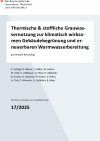
Entwicklung eines Systems zur stofflichen und thermisch-energietechnischen Grauwasserfiltratsverwertung zur Bewässerung von Gebäude- und Fassadenbegrünungen zur Reduktion des Energieverbrauchs der Warmwasserbereitstellung und des Wasserverbrauchs von Begrünungssystemen.
Schriftenreihe
17/2025
K. Schlögl, R. Mixan, J. Völker, W. Huber, M. Gräf, K. Hofbauer, U. Pitha, R. Allabashi, B. Pucher, R. Hammer, P. Holzer, S. Hofer, A. Türk, F. Wimmer, G. Jedliczka, B. Mayr Berichte aus
Herausgeber: BMIMI
Deutsch, 112 Seiten
Downloads zur Publikation
Ergebnisband „Urban Data Management“
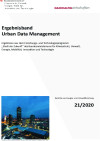
Der vorliegende Ergebnisband stellt abgeschlossene Projekte aus dem Forschungs- und Technologieprogramm „Stadt der Zukunft“ des Bundesministeriums für Klimaschutz, Umwelt, Energie, Mobilität, Innovation und Technologie (BMK) im Bereich Urban Data Management vor. Die gewonnenen Erkenntnisse sollen eine Entwicklung in Richtung energieeffiziente und klimaverträgliche Stadt unterstützen, die auch dazu beiträgt, die Lebensqualität und die wirtschaftliche Standortattraktivität zu erhöhen.
Schriftenreihe
21/2020
Redaktionelle Gestaltung: Bianca Pfefferer, Hannes Warmuth (ÖGUT)
Herausgeber: BMK
Deutsch, 24 Seiten
Downloads zur Publikation
Ergebnisband „Klimaneutrale Städte"
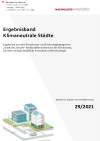
Der vorliegende Ergebnisband stellt abgeschlossene Projekte aus dem Forschungs- und Technologieprogramm „Stadt der Zukunft“ des Bundesministeriums für Klimaschutz, Umwelt, Energie, Mobilität, Innovation und Technologie (BMK) im Bereich Klimaneutrale Städte vor. Die gewonnenen Erkenntnisse sollen eine Entwicklung in Richtung energieeffiziente und klimaverträgliche Stadt unterstützen, die auch dazu beiträgt, die Lebensqualität und die wirtschaftliche Standortattraktivität zu erhöhen.
Schriftenreihe
29/2021
Redaktionelle Gestaltung: Bianca Pfefferer, Hannes Warmuth (ÖGUT)
Herausgeber: BMK
Deutsch, 22 Seiten
Downloads zur Publikation
Ergebnisband „Gebäudetechnologien“
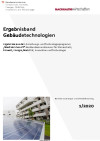
Der vorliegende Ergebnisband stellt abgeschlossene Projekte aus dem Forschungs- und Technologieprogramm „Stadt der Zukunft“ des Bundesministeriums für Klimaschutz, Umwelt, Energie, Mobilität, Innovation und Technologie (BMK) im Bereich innovativer Gebäudetechnologien vor. Die gewonnenen Erkenntnisse sollen eine Entwicklung in Richtung energieeffiziente und klimaverträgliche Stadt unterstützen, die auch dazu beiträgt, die Lebensqualität und die wirtschaftliche Standortattraktivität zu erhöhen.
Schriftenreihe
1/2020
Redaktionelle Gestaltung: Bianca Pfefferer, Hannes Warmuth (ÖGUT)
Herausgeber: BMK, Aktualisierung: Mai 2021
Deutsch, 25 Seiten
Downloads zur Publikation
Ergebnisband „Urbane Wärme und Kälte“
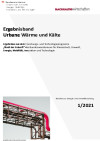
Der vorliegende Ergebnisband stellt abgeschlossene Projekte aus dem Forschungs- und Technologieprogramm „Stadt der Zukunft“ des Bundesministeriums für Klimaschutz, Umwelt, Energie, Mobilität, Innovation und Technologie (BMK) im Bereich Urbane Wärme und Kälte vor. Die gewonnenen Erkenntnisse sollen eine Entwicklung in Richtung energieeffiziente und klimaverträgliche Stadt unterstützen, die auch dazu beiträgt, die Lebensqualität und die wirtschaftliche Standortattraktivität zu erhöhen.
Schriftenreihe
1/2021
Redaktionelle Gestaltung: Bianca Pfefferer, Hannes Warmuth (ÖGUT)
Herausgeber: BMK
Deutsch, 24 Seiten
Downloads zur Publikation
Grüne und resiliente Stadt - Steuerungs- und Planungsinstrumente für eine klimasensible Stadtentwicklung
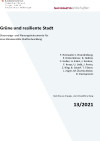
Ziel des Projekts war ein „Proof of Concept“ eines Regelkreises und Tool-Sets zur Steuerung, Optimierung und Evaluierung einer grünen und klimasensiblen Stadt(teil)planung bestehend aus städtebaulichen und freiraumplanerischen Instrumenten sowie Klimasimulationen auf unterschiedlichen Maßstabsebene.
Schriftenreihe
13/2021
F. Reinwald, C. Brandenburg, P. Hinterkörner, B. Hollósi, C. Huber, A. Kainz, J. Kastner, F. Kraus, U. Liebl, J. Preiss, Z. Ring, B. Scharf, T. Tötzer, J. Züger, M. Žuvela-Aloise, D. Damyanovic
Herausgeber: BMK
Deutsch, 124 Seiten
Downloads zur Publikation
HEDWIG - Erhebung von Mess-Daten zur Wirkungsabschätzung von begrünten Gebäuden
HEDWIG verfolgt die Erfassung und Einschätzung der Wirkung von Grünfassaden und -dächern an Gebäuden anhand von Mikroklima- und bauphysikalisch relevanten Daten aus Dauermessungen. Ziel ist die Definition fundierter Vegetationsparameter und Leistungskennwerte auf Innen-, Außen- sowie mikroklimatisch relevanter Stadtraumebene. Es werden Standardkennwerte sowie ein Ablaufschema für standardisierbare Auswertungsverfahren vorliegen.
HEDWIG - Collection of measurement data to assess the impact of green buildings
HEDWIG aims for the assessment of effects from green roofs and facades on buildings by using monitoring data referring to microclimate and building physics. The objective is to define validated vegetation parameters and performance indicators on indoor and outdoor level and on microclimatic relevant street space level. Standardised indicators, evaluation and analysis procedures will be elaborated.
GrünPlusSchule@Ballungszentrum - Hocheffiziente Fassaden- und Dachbegrünung mit Photovoltaik Kombination; optimale Lösung für die Energieeffizienz in gesamtökologischer Betrachtung
Im Rahmen dieses Projektes wurden an einer Wiener Schule unter Einbindung von SchülerInnen, unterschiedliche Gebäudebegrünungs-Systeme und Pflanzen-/Substratarten, kombiniert mit verschiedenen PV-Modulen, untersucht und ihre Einflüsse auf das hygrothermische Verhalten der Gebäude, Energiesparpotential, Raumluftqualität, Luftfeuchtigkeit, Beschattung, Lärmminderung, Wasserrückhaltung und des Wärmeinseleffekts wissenschaftlich erläutert.
KELVIN - Reduktion städtischer Wärmeinseln durch Verbesserung der Abstrahleigenschaften von Gebäuden und Quartieren
Potentialabschätzung einer möglichen Abschwächung des Auftretens städtischer Wärmeinseln durch die Veränderung der Oberflächenalbedo unterschiedlicher Stadtstrukturen (Boden, Dachflächen, Dachbegrünung etc.) bzw. damit verbundener Energieeinsparung durch Reduktion des Kühlungsbedarfs und Emissionsreduktion, um positive Auswirkungen auf Gesundheit und Lebensqualität (Human- und Wohnkomfort) in Städten zu ermöglichen.
